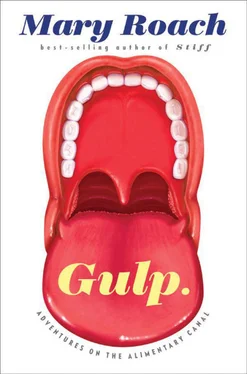“Vesuvius is puking lava at an alarming rate.”
A summary of Chittenden’s project appears in the June 1903 issue of Popular Science Monthly , on the same page as an account of the Havre Two-Legged Horse, a foal born without forelegs, resembling a kangaroo “but with less to console it, since the latter has legs in front, which, while small and short are better than none at all.” On a more upbeat note, the foal was “very healthy and obtains its food from a goat.”
“Put 2 and ½ pounds of guano with 3 qts of water in an enamel stew-pan, boil for 3 or 4 hours, then let it cool. Separate the clear liquid, and about a quart of this healthy extract is obtained.” Use sparingly, cautions the author, or it “will be as repugnant as pepper or vinegar.”
The human digestive tract is like the Amtrak line from Seattle to Los Angeles: transit time is about thirty hours, and the scenery on the last leg is pretty monotonous.
“It can even vomit,” boasts its designer. No reply arrived in response to an e-mail asking whether and into what the Model Gut excretes.
More recently, the digestive action of a healthy adult male obliterated everything but 28 bones (out of 131) belonging to a segmented shrew swallowed without chewing. (Debunking Fletcher wasn’t the intent. The study served as a caution to archaeologists who draw conclusions about human and animal diets based on the skeletal remains of prey items.) The shrew, but not the person who ate it, was thanked in the acknowledgments, leading me to suspect that the paper’s lead author, Peter Stahl, had done the deed. He confirmed this, adding that it went down with the help of “a little bit of spaghetti sauce.”
The Beaumont findings were pointed out to Fletcher in a discussion that followed a lecture of his at a 1909 dental convention in Rochester, New York. “It made no practical difference whether the food was previously masticated very thoroughly, or whether the morsel… was introduced… in one solid chunk,” said an audience member. Before Fletcher could reply, two more doctors chimed with opinions on this and that. By the time Fletcher spoke again, two pages farther into the transcript, the mention of Beaumont was either forgotten or conveniently ignored. At any rate, Fletcher didn’t address it.
Using the tongue is less peculiar than it seems. Before doctors could ship patients’ bodily fluids off to labs for analysis, they sometimes relied on tongue and nose for diagnostic clues. Intensely sweet urine, for instance, indicates diabetes. Pus can be distinguished from mucus, wrote Dr. Samuel Cooper in his 1823 Dictionary of Practical Surgery, by its “sweetish mawkish” taste and a “smell peculiar to itself.” To the doctor who is still struggling with the distinction, perhaps because he has endeavored to learn surgery from a dictionary, Cooper offers this: “Pus sinks in water; mucus floats.”
The shipping of bodily fluids was a trying business in the 1800s. One shipment to Europe took four months. Bottles would arrived “spilt” or “spoilt” or both. One correspondent, taking no chances, directed Beaumont to ship the secretions “in a Lynch & Clark’s pint Congress water bottle, carefully marked, sealed and capped with strong leather and twine, cased in tin, with the lid soldered on.”
Except possibly Irwin Mandel. Mandel was the author of a hundred papers on saliva. A winner of the Salivary Research Award. The subject of a lush tribute in the Journal of Dental Research in 1997. The editor of the Journal of Dental Research in 1997. Mandel did not go so far as to write the tribute himself. That was done by B. J. Baum, P. C. Fox, and L. A. Tabak. Having three authors means no one man can be blamed for the sentence “Saliva was his vehicle and he went with the flow.”
I can vouch for this. I once toured the refrigerator at Hill Top Research, where odor judges test the efficacy of deodorizing products like mouthwash and cat litter. The president at the time, Jack Wild, was looking for the malodor component of armpit smell, which I had asked to sample. He kept opening little jars, going, “Nope, that’s dirty feet, no, that’s fishy amines” (vaginal odor). I asked him which is the worst. “Incubated saliva,” he said without hesitating. “Both Thelma and I got dry heaves.” I don’t recall Thelma’s title. Whatever she did, she deserved a raise.
Less high-tech than it sounds. Subjects leaned over and spat into the machine every two minutes. A slight improvement over the earliest collection technique, circa 1935: “The subject sits with head tilted forward, allowing the saliva to run to the front of the mouth… and drip out between parted lips.” A photo in Kerr’s monograph shows a nicely dressed woman, hair bobbed, hands palm down on the table in front of her, forehead resting in a support. An enamel basin is positioned just so, to catch the drippings.
But nothing compared to crow droppings. According to Harper, the traditional purification ritual for the Brahmin polluted by crow feces is “a thousand and one baths.” This has been rendered less onerous by the invention of the showerhead and the crafty religious loophole. “The water coming through each hole counts as a separate bath.”
Or, as of 2007, an adult. Egyptian scholar Ezzat Attiya issued a fatwa, or religious opinion, extending breast-milk-son status to anyone a woman has “symbolically breastfed.” For convenience’s sake, drivers and deliverymen could, by drinking five glasses of a woman’s breast milk, be permitted to spend time alone with her. In the ensuing ruckus, another scholar insisted the man would have to drink directly from the woman’s breast. Which is crazier: that Saudi courts, in 2009, sentenced a woman to forty lashes and four months in prison for allowing a bread deliveryman inside her home, or the notion that she might have avoided punishment by letting him suckle from her breast? The woman was seventy-five, if that helps you with your answer.
But not its bubbles. Frothiness is a hallmark of proteins in general; saliva has more than a thousand kinds. Proteins bind to air. When you whip cream or beat eggs, you are exposing maximum numbers of proteins to air, which is then pulled into the liquid, forming bubbles. That disturbing white foam on the cheeks and necks of racehorses is saliva whisked by the bit. (The whisking of semen is complicated by its coagulating factor. Should you wish to know more, I direct you to the mucilaginous strands of the World Wide Web.)
Literally. The coating is real silver. That’s why the label says “For Decorative Use Only.” Like everyone else, environmental lawyer Mark Pollock didn’t realize you weren’t supposed to eat them. In 2005, Pollock sued PastryWiz, Martha Stewart Living Omnimedia, Dean & DeLuca, and a half-dozen other purveyors of silver dragees, as they are known in the business. Pollock succeeded in getting the product off store shelves in California. Fear not, holiday bakers, silver dragees are available in abundance from online sellers, along with gold dragees, mini dragees, multicolored pastel dragees. And dragee tweezers. (With cupped ends “to easily grab individual dragees.”)
As does this: Claims made by makers of mouthwash to kill 99 percent of oral bacteria are misleading. Silletti says half the species can’t be cultured in a lab; they grow only in the mouth. Or on other bacteria. “When you ask the companies for claim support, they will show you the statistics for the kinds they can culture.” How many others there are, or what mouthwash does to them, is unknown.
Читать дальше












